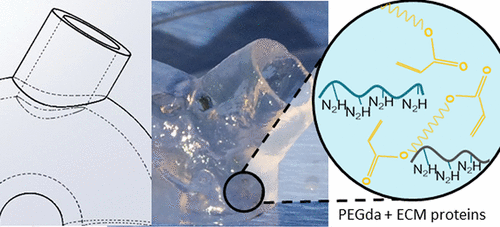当前位置:
X-MOL 学术
›
Biomacromolecules
›
论文详情
Our official English website, www.x-mol.net, welcomes your
feedback! (Note: you will need to create a separate account there.)
3D Printed Pericardium Hydrogels To Promote Wound Healing in Vascular Applications
Biomacromolecules ( IF 5.5 ) Pub Date : 2017-10-16 00:00:00 , DOI: 10.1021/acs.biomac.7b01165 Laura G. Bracaglia , Michael Messina , Shira Winston , Che-Ying Kuo 1 , Max Lerman 2 , John P. Fisher
Biomacromolecules ( IF 5.5 ) Pub Date : 2017-10-16 00:00:00 , DOI: 10.1021/acs.biomac.7b01165 Laura G. Bracaglia , Michael Messina , Shira Winston , Che-Ying Kuo 1 , Max Lerman 2 , John P. Fisher
Affiliation

|
Vascular grafts that can support total replacement and maintenance by the body of the injured vessel would improve outcomes of major surgical reconstructions. Building scaffolds using components of the native vessel can encourage biological recognition by native cells as well as mimic mechanical characteristics of the native vessel. Evidence is emerging that incorporating predetermined building-blocks into a tissue engineering scaffold may oversimplify the environment and ignore critical structures and binding sites essential to development at the implant. We propose the development of a 3D-printable and degradable hybrid scaffold by combining polyethylene glycol (PEG)acrylate and homogenized pericardium matrix (HPM) to achieve appropriate biological environment as well as structural support. It was hypothesized that incorporation of HPM into PEG hydrogels would affect modulus of the scaffold and that the modulus and biological component would reduce the inflammatory signals produced from arriving macrophages and nearby endothelial cells. HPM was found to provide a number of tissue specific structural proteins including collagen, fibronectin, and glycosaminoglycans. HPM and PEGacrylate formed a hybrid hydrogel with significantly distinct modulus depending on concentration of either component, which resulted in scaffolds with stiffness between 0.5 and 20 kPa. The formed hybrid hydrogel was confirmed through a reduction in primary amines post-cross-linking. Using these hybrid scaffolds, rat bone marrow derived macrophages developed an M2 phenotype in response to low amounts (0.03%, w/v) of HPM in culture but responded with inflammatory phenotypes to high concentrations (0.3%, w/v). When cultured together with endothelial cells, both M1 and M2 macrophages were detected, along with a combination of both inflammatory and healing cytokines. However, the expression of inflammatory cytokines TNFα and IL1β was significantly (p < 0.05) lower with hybrid hydrogels compared to single component PEG or HPM hydrogels. This reduction in inflammatory cytokines could impact the healing environment that persists at the implantation site. Finally, using this developed hybrid hydrogel, models of neonatal vasculature were manufactured using digital light projection (DLP) 3D printing. The structural control achieved with this novel biomaterial suggests a promising new tool in vascular graft development and research, with potential for complex structures for use in congenital heart defect reconstruction.
中文翻译:

3D打印的心包水凝胶可促进血管应用中的伤口愈合
血管移植物可以支持受伤血管的全部置换和维持,将改善大型外科手术重建的效果。使用天然血管的组分构建支架可以促进天然细胞的生物学识别以及模拟天然血管的机械特性。越来越多的证据表明,将预定的构建基块掺入组织工程支架中可能会过度简化环境,而忽略植入物发育必不可少的关键结构和结合位点。我们建议通过结合聚乙二醇(PEG)丙烯酸酯和均质的心包基质(HPM)来开发3D可打印和可降解的混合支架,以实现适当的生物环境以及结构支持。假设将HPM掺入PEG水凝胶将影响支架的模量,并且模量和生物学成分将减少由到达的巨噬细胞和附近的内皮细胞产生的炎症信号。发现HPM可提供多种组织特异性结构蛋白,包括胶原蛋白,纤连蛋白和糖胺聚糖。HPM和PEG丙烯酸酯形成的杂化水凝胶具有明显不同的模量,具体取决于任一组分的浓度,从而导致支架的刚度在0.5到20 kPa之间。交联后伯胺的减少证实了形成的杂化水凝胶。使用这些杂种支架,大鼠骨髓来源的巨噬细胞可响应少量(0.03%,w / v)培养中的HPM,但对高浓度(0.3%,w / v)的炎症表型有反应。与内皮细胞一起培养时,同时检测到M1和M2巨噬细胞,以及炎症和愈合细胞因子的组合。然而,炎症细胞因子TNFα和IL1β的表达显着(与单组分PEG或HPM水凝胶相比,杂化水凝胶的p <0.05)更低。炎性细胞因子的这种减少可能影响在植入部位持续存在的愈合环境。最终,使用这种开发的混合水凝胶,使用数字光投影(DLP)3D打印技术制造了新生儿脉管系统模型。用这种新型生物材料实现的结构控制表明,在血管移植物的开发和研究中,它是一种很有前途的新工具,具有用于先天性心脏缺陷重建的复杂结构的潜力。
更新日期:2017-10-17
中文翻译:

3D打印的心包水凝胶可促进血管应用中的伤口愈合
血管移植物可以支持受伤血管的全部置换和维持,将改善大型外科手术重建的效果。使用天然血管的组分构建支架可以促进天然细胞的生物学识别以及模拟天然血管的机械特性。越来越多的证据表明,将预定的构建基块掺入组织工程支架中可能会过度简化环境,而忽略植入物发育必不可少的关键结构和结合位点。我们建议通过结合聚乙二醇(PEG)丙烯酸酯和均质的心包基质(HPM)来开发3D可打印和可降解的混合支架,以实现适当的生物环境以及结构支持。假设将HPM掺入PEG水凝胶将影响支架的模量,并且模量和生物学成分将减少由到达的巨噬细胞和附近的内皮细胞产生的炎症信号。发现HPM可提供多种组织特异性结构蛋白,包括胶原蛋白,纤连蛋白和糖胺聚糖。HPM和PEG丙烯酸酯形成的杂化水凝胶具有明显不同的模量,具体取决于任一组分的浓度,从而导致支架的刚度在0.5到20 kPa之间。交联后伯胺的减少证实了形成的杂化水凝胶。使用这些杂种支架,大鼠骨髓来源的巨噬细胞可响应少量(0.03%,w / v)培养中的HPM,但对高浓度(0.3%,w / v)的炎症表型有反应。与内皮细胞一起培养时,同时检测到M1和M2巨噬细胞,以及炎症和愈合细胞因子的组合。然而,炎症细胞因子TNFα和IL1β的表达显着(与单组分PEG或HPM水凝胶相比,杂化水凝胶的p <0.05)更低。炎性细胞因子的这种减少可能影响在植入部位持续存在的愈合环境。最终,使用这种开发的混合水凝胶,使用数字光投影(DLP)3D打印技术制造了新生儿脉管系统模型。用这种新型生物材料实现的结构控制表明,在血管移植物的开发和研究中,它是一种很有前途的新工具,具有用于先天性心脏缺陷重建的复杂结构的潜力。











































 京公网安备 11010802027423号
京公网安备 11010802027423号